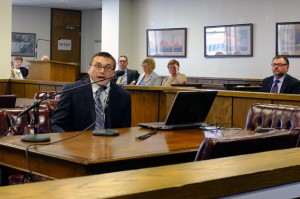
Austin Holland with the Oklahoma Geological Survey briefs Corporation Commissioners on new earthquake research.
Joe Wertz / StateImpact Oklahoma


Austin Holland with the Oklahoma Geological Survey briefs Corporation Commissioners on new earthquake research.
Joe Wertz / StateImpact Oklahoma

Joe Wertz / StateImpact Oklahoma
Austin Holland with the Oklahoma Geological Survey briefs Corporation Commissioners on new earthquake research.
The Oklahoma Corporation Commission has stepped up monitoring and inspections of disposal wells in earthquake-prone regions of the state as regulators, scientists and energy companies gather new information on the links between earthquakes and oil and gas production.
Officials with the Corporation Commission — the state’s oil and gas regulator — are focusing on a small fraction of the roughly 12,000 injection wells where oil and gas waste is pumped deep underground, said the agency’s Tim Baker.
“If we were looking for a suspect that may be contributing to the problem, we are focusing on the high-capacity, high-volume Arbuckle disposal wells,” Baker said at Tuesday’s commission meeting. Baker manages the agency division that oversees disposal wells, which university, state and federal researchers say could be contributing much of the seismic activity.
For months, the agency has been asking those seeking disposal wells in quake-prone regions to supply extra information before it administratively approves a permit. Roughly 117 wells in central and north-central Oklahoma are receiving extra scrutiny, and their operators have volunteered to supply the agency and researchers with extra pressure and disposal volume measurements, Baker said.
The Commission approved stricter monitoring rules for disposal well operators that go into effect on Sept. 12, but the state’s seismologist, Austin Holland with the Oklahoma Geological Survey, said many energy companies are supplying even more data — including closely guarded proprietary analyses known as 3-D seismic surveys — to help scientists study the phenomenon.
The Geological Survey has recently stepped up its earthquake research capability by adding two full-time staff members, and is adding new monitoring stations with a grant from the U.S. Department of Energy and matching funds from the Corporation Commission and the office of the Oklahoma Secretary of Energy and Environment, Holland told the commission.